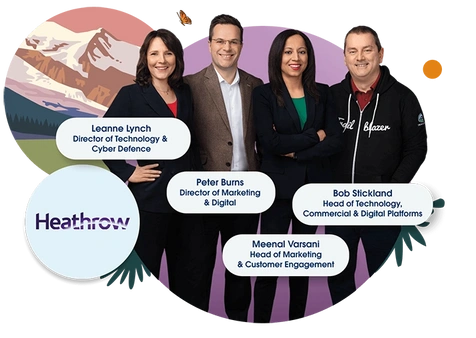The art of emotional marketing: how to boost your B2B strategy
Published on September 21, 2023 - Updated on December 05, 2023
The art of emotional marketing: how to boost your B2B strategy
Emotional marketing has been on the rise for many years, primarily in the B2C (Business-to-Consumer) sector. However, even though it may seem less obvious, it is equally applicable to B2B. In this article, you will discover why emotional marketing is essential in B2B, how to integrate it into your strategy, and how to create lasting connections with potential clients. Dive into the world of emotions and learn how to revolutionize your B2B marketing approach.
A quick reminder: what is B2B?
Let's begin with a reminder of what B2B (Business-to-Business) means. B2B refers to all commercial transactions and business relationships established between companies. Unlike B2C, where businesses sell directly to consumers, B2B involves selling products, services, or solutions between businesses or professionals.
B2B marketing aims to reach these businesses and influence their buying decisions using strategies tailored to this specific context. It is often perceived as a discipline focused on rationality, logic, and numbers. Interactions between businesses are considered devoid of emotion, unlike the world of B2C where brands actively seek to evoke emotions to drive impulse purchases. However, it is becoming increasingly clear that B2B, far from being devoid of emotions, provides fertile ground for exploring and leveraging the emotional dimension in business relationships.
Evolution of B2B marketing: from reason to emotion
For decades, B2B marketing has been characterized by its rational approach. Buying decisions were primarily based on criteria such as technical specifications, price, and delivery times. However, recent studies have revealed that the emotional aspect plays a crucial role in the B2B buying process. Contrary to popular belief, B2B professionals are also sensitive to emotions, and these emotions influence their decisions more than previously thought. It's important to note that the majority 90%of purchasing decisions actually form in our subconscious, where our emotions reside. In other words, emotional and psychological motivation often outweigh purely factual considerations, making emotions a key lever for influencing business choices.
Why should we use emotional marketing in B2B?
It may seem surprising that, in the realm of B2B marketing, buyers rely more on their emotions than on rational arguments to make decisions. However, this trend is partly explained by the similarity of offers in the market. A recent study by CSO Insights revealed that only 14% of the value propositions presented by salespeople are relevant enough to prompt the customer to take action. In other words, most of the time (86% of the time), their sales messages are not relevant.
Given the challenge of standing out in a market where offers often appear similar, buying decisions are influenced by the customer experience, which includes emotions, as well as brand content. Therefore, it's essential to implement a strategy that effectively integrates emotions into the B2B marketing approach.
McKinsey's research shows that 71% of consumers expect personalized interactions from companies, and it doesn't stop there: 76% of them get frustrated when it doesn't happen. Moreover, the positive emotional impact of a personal choice is much stronger than that of purely rational arguments. This can be relevant in capturing the attention of potential clients, reinforcing the crucial importance of branding in the world of business and customer relations.
It's worth noting that while the B2B purchasing process is generally longer than in B2C, the emotions solicited are not the same. As a result, emotions like trust, optimism, and courage, which can be associated with more primary emotions such as joy, positive surprise, or fear, are more effective in influencing B2B buying decisions, according to a study conducted by dentsuMB.
Emotions in B2B buying decisions
The power of emotions is clearly highlighted by the results of a survey published by The Good Relations Group:
93% emphasized the importance of working with an honest supplier.
91% purchased products and services based on personal recommendations.
73% are influenced in their buying decision by a strong brand perception.
Furthermore, the study from the B2B Institute shows that B2B marketing strategies that appeal to emotions, rather than purely rational aspects, are 7 times more effective at generating sales, revenue, and long-term profits while helping you reach your target audience.
Surprisingly, Google's research on emotions in B2B digital marketing is also noteworthy. Counterintuitively, Google found that B2B prospects are more emotionally invested in products or services than B2C customers. They concluded that inherent personal rewards for B2B participants are a significant persuasive factor.
"B2B buyers are almost 50% more likely to purchase a product or service when they see personal value—such as the opportunity to advance their career or confidence and pride in their choice—in their business buying decision. They are 8 times more likely to pay a premium for comparable products and services when personal value is present." – Google Research
A study conducted by Les Binet and Peter Field for the LinkedIn B2B Institute corroborated this finding. It highlighted that B2B approaches that incorporate an emotional dimension are 7 times more effective at driving sales and long-term revenue compared to predominantly rational messages, including customer loyalty.

Although B2B involves transactions between businesses, it is important to remember that individuals ultimately make the decisions. This reality is supported by the theory of bounded rationality by renowned economist Herbert Simon. According to this theory, decision-makers face numerous constraints and cannot always consider all rational elements related to their decision. Therefore, they tend to opt for solutions that are satisfactory rather than optimal.
Putting it into practice: strategies for B2B emotional marketing
Now that we understand the importance of emotions in B2B, let's explore some strategies and practices to effectively incorporate this emotional dimension into your marketing plan, particularly through content marketing.
1) Understanding the emotions of your personas
In any marketing strategy, personas play a crucial role. The goal of marketing professionals is to deliver the right message to the right person at the right time. However, this cannot solely rely on rational elements.
For example, if you want to offer a solution to a restaurant group manager, it's imperative to deeply understand them. You must identify what motivates them, their concerns, factors that might make them hesitate, and more. This approach demonstrates empathy toward your personas and provides real added value.
2) Improving messages and content
In the context of inbound marketing, the most effective way to attract personas to your website is to demonstrate that you understand their problems. Then, you must guide them step by step toward solving these problems, using various distribution channels such as social media, email, and blogs.
Concerning content marketing, it's generally recommended to start with a difficult situation, fear, or problem and then offer a solution or relief. This can also involve building trust and optimism. As mentioned earlier, these are the emotions identified as effective in B2B.
The real challenge lies in mastering the art of balancing these emotions in your messages and content. Therefore, it's essential to get to know your audience and adapt your messages based on their behavior. This can be achieved through in-depth analysis and marketing campaigns specifically designed to evoke positive emotions in your B2B clients.
3) Measuring the impact of your actions
Evaluating whether you've successfully elicited the right emotions is not an easy task. To do this, it's necessary to analyze the impact of each marketing action taken, using relevant Key Performance Indicators (KPIs) tailored to the digital context. If, for example, an email marketing campaign generates a low click-through rate, or if a landing page fails to convince and convert effectively, it's highly likely that the emotional approach needs revision. Consequently, you'll need to adjust your message.
Furthermore, to measure customer experience and emotions of customers or prospects, it's essential to closely monitor signals emitted by your target audience on social media, forums, and review sites. If negative comments are identified, taking appropriate measures is paramount.
Finally, there are numerous tools like the Q°emotion SaaS platform that can be used to measure customer satisfaction, and using them can greatly contribute to the improvement of your B2B strategy.
Inspiring brands: concrete results
Several B2B companies have successfully integrated emotions into their marketing strategies, thereby enhancing customer loyalty. Here are some inspiring examples:
Salesforce: "Customer Success Stories"
Salesforce successfully evoked emotions in its B2B audience by sharing emotional case studies highlighting the success of their clients. These stories illustrate how Salesforce helped its clients overcome challenges and achieve their goals. By showcasing the positive impact of their service, Salesforce strengthened the trust and loyalty of its customers.

Ici, Salesforce partage son histoire avec l’Aéroport d’Heathrow pour illustrer comment son logiciel a permis à Heathrow d’améliorer son expérience client, d’augmenter ses revenus et de devenir l’un des aéroports les plus fréquentés d’Europe. Cette histoire met en avant comment Salesforce aide les entreprises à offrir des expériences clients plus personnalisées, à mieux comprendre leurs clients, à augmenter leurs revenus et à fournir un service plus efficace.
Adobe : "Adobe For All"
Adobe used emotional marketing to promote diversity and inclusion. By demonstrating their commitment to these values, they stirred positive emotions in their B2B audience. This approach enhanced their brand image and allowed them to stand out as a socially responsible company.

Saint gobain : “Multi-Comfort House”
In 2018, Saint-Gobain launched an advertising campaign titled "Multi-Comfort House" to promote its thermal insulation products. The campaign highlighted the benefits of thermal insulation for the health and well-being of house occupants. The campaign was a success and allowed Saint-Gobain to strengthen its position in the thermal insulation market.

Conclusion
In conclusion, emotional marketing is a powerful strategy that has found its place in the world of B2B. It goes beyond features and specifications to focus on human relationships. By understanding the needs, desires, and motivations of your potential clients, you can create stronger and more lasting connections.
By integrating emotional marketing into your strategy, you can increase customer loyalty, boost conversions, and improve profitability. It's an approach that demands empathy, creativity, and understanding, but the results are worth it. So, explore the potential of emotional marketing and transform your business to thrive in the demanding world of B2B.
Similar posts
Customer Experience vs. Customer Success: Understanding the differences and maximising customer loyalty through emotional analysis
Published on October 29, 2024 - Updated on November 04, 2024
In an increasingly competitive business environment, companies must now redouble their efforts to capture and retain customers. According to a recent study by Forrester , 73% of companies now...
Reduce holiday stress with Q°emotion: How brands can manage customer emotions over Christmas
Published on October 29, 2024 - Updated on February 14, 2025
Reduce holiday stress with Q°emotion: How brands can manage customer emotions over Christmas Introduction: The Christmas paradox Although Christmas is traditionally a time of joy, sharing and celeb...